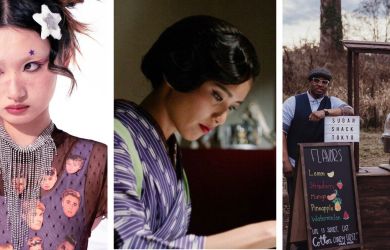
Originally published on metropolis.co.jp on December 2012

A marketing gimmick designed to sell a stuffed bear has spawned a devoted cult following in Japan rivaling the Cabbage Patch Kids and Furby toy fads of the ’80s and ’90s. But what is it about an ordinary, mass produced teddy bear named Duffy that has the Japanese so infatuated?
Within minutes of arriving at Tokyo DisneySea you’ll notice the cuddly brown bear everywhere: children tote around multiple bears often bigger than them; teenagers hang dozens of Duffy key rings from backpacks; and middle-aged women buy mini outfits and accessories, then whisper to their treasured bears.
Duffy even challenges Disney’s rodent hero for top spot in the popularity contest—at Tokyo DisneySea, anyway. There, Duffy’s the new Cabbage Patch Kid: capable of stirring fanciful imaginings that it’s not a toy, but something in need of love and care.
In the ’80s, Cabbage Patch Kids were the “must have” toy—one man flew from Kansas City to London to buy one for his daughter. Their popularity spawned riots at stores around the US and in 1983, the dolls made the cover of Newsweek’s Christmas issue. The hype was so intense, myths began circulating that they had satanic powers, or were modeled on what newborn children would look like after a nuclear war. Some women, unable to bear children, “adopted” Cabbage Patch Kids instead, becoming convinced the toys were alive, and needed to be cared for. Could Duffy fuel this type of hysteria?
It takes more than a pert profile to create such a massively successful piece of merchandise. Behind the phenomenon is the cunning linkage of the furry friend to two of Japan’s biggest interests: fashion and photography. In a feat of marketing genius, the PR people added a back story that will ensure the cuddly critter stays fresh for generations to come. The tale goes that Minnie Mouse gave Mickey the bear as a symbol of happiness and luck before he set off on a voyage on the high seas. A sentimental yarn designed to inspire consumers to take their toys on adventures, kitted out in the latest attire.
Duffy’s success story closely mimics one of Japan’s most famous and cutest exports—Hello Kitty. Worth more than ¥400 billion, the mouthless cat won over the hearts of Japanese people the moment she was released in 1974 on a vinyl coin purse. Hello Kitty is now a popular character in more than 60 countries, the face of two theme parks, and has even graced an Airbus A330—EVA Airways Hello Kitty Jet. To keep her in vogue, Hello Kitty’s “look” is regularly updated to reflect the current fashions and trends.
Never one to be out of style, Duffy’s designers introduce new outfits and accessories every month, which means return visits to DisneySea by enthusiasts. Large stores inside the park are sole Duffy-dedicated retail outlets. Staff are constantly restocking and there are limits to the number of items you can buy from certain ranges, making it somewhat of a collector’s toy—though it’s far from rare.
The marketers have beautifully tapped into the Japanese “want” mentality. If it’s hot, they’ve got to have it, no matter the price—or even what it is. In the stores after 9pm, when people are starting to go home, madness ensues. Shoppers grab at items without even looking, desperate as they are to fill their baskets with as much Duffy merchandise as possible. And none of it is cheap.
A survey by the Japan Youth Research Institute found Japanese youth are far more brand-aware than their peers in the United States, China and South Korea. They want it, and they want everyone else to know they’ve got it. That’s how Louis Vuitton’s high-end, heavily branded products fit right in, and whereas other countries are crowded with fakes, you’ll be hard pressed to find a knock-off in Japan—especially Tokyo—where approximately half of all Louis Vuitton’s goods are sold.
“It’s our group mentality,” a Japanese friend told me. “It’s conformist thinking—if everyone else likes it, it must be good, even if they don’t really like it personally. People live in such close proximity to each other, they start to follow the crowd without realizing or questioning it.”
But consumer psychology aside, Japan’s obsession with kawaii is fuelling the economy like the jet rockets that fuel Astro Boy.
So if you head out to Tokyo DisneySea over the holidays and see a long line, it’s probably not for caramel popcorn or even the new Toy Story ride. It’s most likely Duffy fans patiently waiting to take a photo of their bears in their new Christmas outfits and quietly whispering sweet nothings into their plush stuffed ears. Kawaii, indeed.





